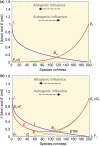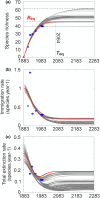A niche-based theory of island biogeography
- PMID: 38932973
- PMCID: PMC11199848
- DOI: 10.1002/ece3.11540
A niche-based theory of island biogeography
Abstract
The equilibrium theory of island biogeography (ETIB) is a widely applied dynamic theory proposed in the 1960s to explain why islands have coherent differences in species richness. The development of the ETIB was temporarily challenged in the 1970s by the alternative static theory of ecological impoverishment (TEI). The TEI suggests that the number of species on an island is determined by its number of habitats or niches but, with no clear evidence relating species richness to the number of niches however, the TEI has been almost dismissed as a theory in favour of the original ETIB. Here, we show that the number of climatic niches on islands is an important predictor of the species richness of plants, herpetofauna and land birds. We therefore propose a model called the niche-based theory of island biogeography (NTIB), based on the MacroEcological Theory on the Arrangement of Life (METAL), which successfully integrates the number of niches sensu Hutchinson into ETIB. To account for greater species turnover at the beginning of colonisation, we include higher initial extinction rates. When we test our NTIB for resident land birds in the Krakatau Islands, it reveals a good correspondence with observed species richness, immigration and extinction rates. Provided the environmental regime remains unchanged, we estimate that the current species richness at equilibrium is ~45 species (range between 38.39 and 61.51). Our NTIB provides better prediction because it counts for changes in species richness with latitude, which is not considered in any theory of island biogeography.
Keywords: area; biodiversity; island biogeography; niche theory.
© 2024 The Author(s). Ecology and Evolution published by John Wiley & Sons Ltd.
Conflict of interest statement
The authors declare no competing financial interests.
Figures




References
-
- Abbott, I. , & Grant, P. R. (1976). Nonequilibrial bird faunas on islands. The American Naturalist, 110, 507–528.
-
- Arrhenius, O. (1921). Species and area. Journal of Ecology, 9, 95–99.
-
- Barajas‐Barbosa, M. P. , Weigelt, P. , Borregaard, M. K. , Keppel, G. , & Kreft, H. (2020). Environmental heterogeneity dynamics drive plant diversity on oceanic islands. Journal of Biogeography, 47, 2248–2260.
-
- Beaugrand, G. (2015). Marine biodiversity, climatic variability and global change. Routledge.
LinkOut - more resources
Full Text Sources

